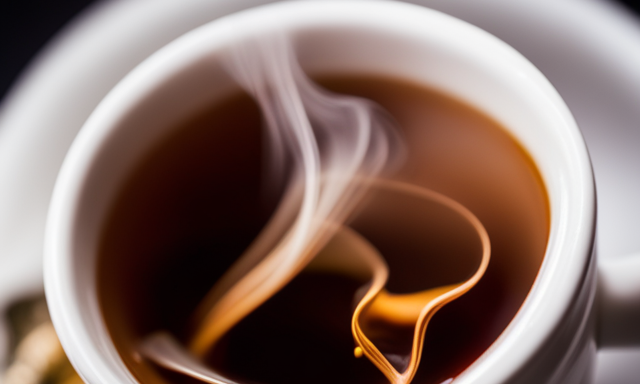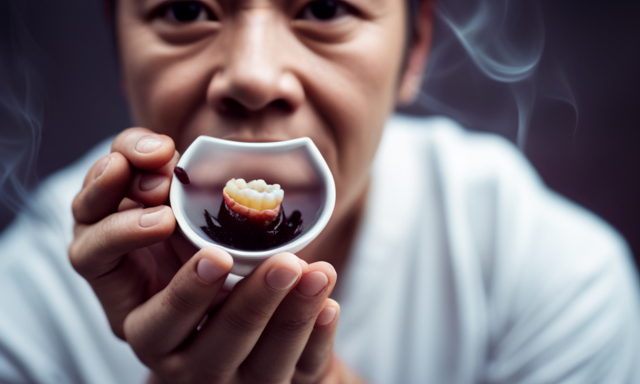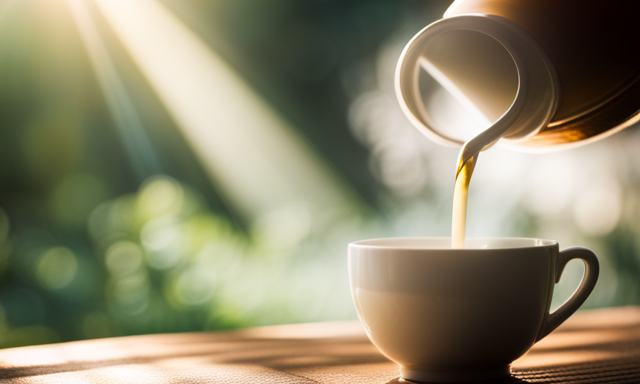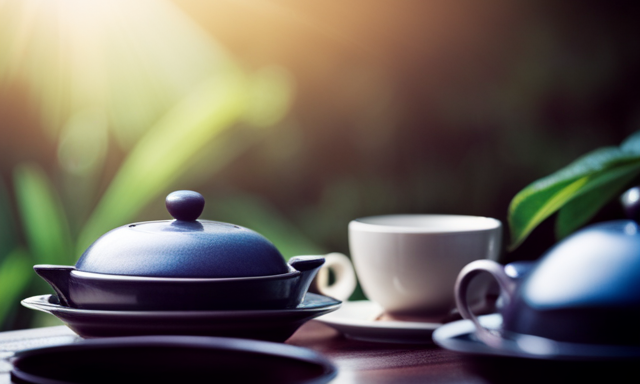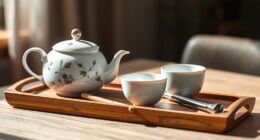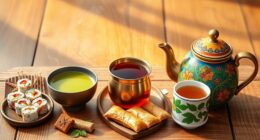As I sip on a steaming cup of oolong tea, I am transported to a world of exquisite flavors and fragrances. The properties of oolong tea are truly remarkable, and I am excited to share them with you.
Oolong tea, with its origins in China, has a fascinating history that dates back centuries. Its unique flavor profile is a result of the oxidation process, which lends a delightful complexity to each brew. From the floral and fruity notes to the earthy undertones, oolong tea offers a sensory experience like no other.
The leaves themselves vary in shape and color, each possessing its own distinctive characteristics. Not only does oolong tea offer a delightful taste, but it is also packed with health benefits. With a moderate caffeine content, it provides a gentle boost of energy without the jitters.
Join me on a journey as we explore the rich cultural significance and brewing techniques of oolong tea, and discover the countless varieties and blends that await us.
Key Takeaways
- Oolong tea has a delicate and complex taste with floral, fruity, earthy, and roasted undertones.
- Brewing techniques, including temperature, steeping time, and tea-to-water ratio, are crucial for proper extraction and to achieve the best flavors.
- Oolong tea has various health benefits, such as aiding digestion, boosting metabolism, reducing the risk of heart disease, improving brain function, regulating blood sugar levels, and promoting healthy skin.
- Oolong tea is a versatile beverage that can be enjoyed hot or cold, steeped multiple times, and paired with various foods. It is popular among tea connoisseurs and can be used as a coffee alternative.
The Origin and History of Oolong Tea
Did you know that oolong tea has a fascinating history and origin story? Oolong tea originated in China and has been cultivated for centuries. The precise origin is debatable, but it’s believed to have started in the Fujian province.
The unique cultivation process involves carefully selecting the tea leaves and allowing them to wither in the sun. Afterward, the leaves are partially oxidized, giving oolong tea its distinct flavor profile. This oxidation process is what sets oolong tea apart from other types of tea. The level of oxidation can vary, resulting in a wide range of flavors, from floral and fruity to toasty and nutty.
Understanding the origin and cultivation of oolong tea helps us appreciate the intricate oxidation process and its effects on flavor, which we’ll explore next.
The Oxidation Process and Its Effects on Flavor
As you steep this fragrant infusion, the leaves undergo a carefully controlled oxidation process, transforming their flavors into a symphony of rich and complex notes. During this process, enzymes in the leaves react with oxygen in the air, causing chemical changes that result in the characteristic flavors of oolong tea. The duration and level of oxidation can vary, leading to a range of flavors from light and floral to deep and roasted. To better understand the effects of oxidation on flavor, let’s take a look at the following table:
| Oxidation Level | Flavor Profile |
|---|---|
| Light (10-30%) | Floral, fruity |
| Medium (30-50%) | Honey, nutty |
| Dark (50-70%) | Roasted, caramel |
| Heavy (70-80%) | Woody, toasty |
| Full (80-90%) | Smoky, robust |
The oxidation process plays a crucial role in shaping the taste and aroma of oolong tea, setting it apart from other types of tea. It is this careful balance of oxidation that gives oolong tea its distinctive and captivating flavors. Now, let’s delve into the next section and explore the specific taste and aroma profiles of oolong tea.
The Distinctive Taste and Aroma of Oolong Tea
Indulging in a cup of oolong is like embarking on a sensory adventure, as its distinctive taste and aroma transport you to a world of intricate flavors and enticing scents.
Oolong tea is known for its unique flavor profile that lies somewhere between green and black tea. It offers a wide range of distinctive flavors, including floral, fruity, and toasty notes, which can vary depending on the specific variety and the level of oxidation.
The brewing methods also play a significant role in bringing out the best flavors of oolong tea. By controlling the water temperature, steeping time, and the number of infusions, one can unlock the full potential of this tea.
As we delve into the variety of oolong tea leaves and their characteristics, we will discover the fascinating world that awaits us in the next section.
The Variety of Oolong Tea Leaves and Their Characteristics
Exploring the range of oolong tea leaves and their unique characteristics allows one to fully appreciate the diverse flavors and scents they offer.
Oolong tea leaves come in various shapes and sizes, ranging from tightly rolled to open and twisted. Each variety has its own distinct flavor profile, influenced by factors such as the region of cultivation, the oxidation process, and the brewing techniques used.
Some oolong teas have fruity and floral notes, while others have a more earthy and roasted taste. The caffeine content in oolong tea varies depending on the specific type, but it generally contains less caffeine compared to black tea.
Oolong tea has a rich cultural significance, with a long history originating in China. Transitioning into the subsequent section about the health benefits of oolong tea, it’s important to note that these leaves offer not only a delightful beverage but also potential wellness advantages.
The Health Benefits of Oolong Tea
Discover the numerous ways that oolong tea can boost your overall well-being and enhance your health. Oolong tea is known for its potential to aid in weight loss. The polyphenols found in oolong tea can help increase metabolism and fat oxidation, making it a great addition to a balanced diet and exercise routine.
Moreover, oolong tea has been shown to reduce stress levels. The combination of caffeine and theanine in oolong tea promotes relaxation and improves mood. This can be particularly beneficial for individuals dealing with stress and anxiety.
In the next section, we’ll explore the caffeine content in oolong tea and its effects on the body. So, let’s dive into the energizing properties of oolong tea and how it can provide you with a natural boost.
The Caffeine Content in Oolong Tea
With its caffeine content, oolong tea can provide a natural energy boost. It contains approximately 37 mg of caffeine per 8-ounce serving, which is less than half the amount found in a cup of coffee. Oolong tea’s moderate caffeine levels offer a gentle pick-me-up without the jitters or crash often associated with higher caffeine beverages.
In addition to its stimulating effects, oolong tea has a range of health benefits. Some of these include improving mental alertness and focus, boosting metabolism, aiding in weight management, promoting heart health, and supporting a healthy immune system. The combination of caffeine and antioxidants found in oolong tea can also help improve digestion and increase energy expenditure.
Transitioning to brewing techniques and recommendations for the perfect cup, let’s explore the best ways to prepare this delightful beverage.
Brewing Techniques and Recommendations for the Perfect Cup
To achieve the perfect cup, you can employ various brewing techniques and follow these recommendations.
The brewing temperature for oolong tea is crucial in order to bring out its complex flavors. Generally, a temperature of 195°F to 205°F (90°C to 96°C) is recommended.
Steeping time also plays a vital role in the taste of your tea. For lighter oolong teas, a steeping time of 2-3 minutes is ideal, while darker oolong teas can be steeped for 4-5 minutes.
Remember, these are just guidelines, and you can adjust the time and temperature based on personal preference.
Once you have brewed your oolong tea to perfection, you can now delve into the cultural significance and rituals surrounding this beloved beverage.
The Cultural Significance and Rituals Surrounding Oolong Tea
Now that we’ve covered the brewing techniques and recommendations for the perfect cup of oolong tea, let’s delve into the fascinating world of the cultural significance and rituals surrounding this tea.
Oolong tea holds a special place in many cultures, particularly in East Asia, where it is often celebrated through tea ceremonies and other cultural practices. These ceremonies are steeped in tradition and are a way to honor the tea’s history and importance. From the precise preparation to the graceful pouring and serving, every step is thoughtfully carried out to create a serene and contemplative atmosphere.
Through these rituals, participants not only enjoy the exquisite taste of oolong tea but also foster a deep connection with the traditions and values it represents.
As we move forward, let’s explore the various oolong tea varieties and blends to further enrich our tea experience.
Oolong Tea Varieties and Blends to Explore and Enjoy
As we delve into the fascinating world of oolong tea varieties and blends, prepare to uncover a whole new realm of flavors and aromas that’ll enhance your tea experience.
Oolong tea, known for its delicate and complex taste profile, offers a wide range of flavors to explore. From floral and fruity notes to earthy and roasted undertones, each variety brings something unique to the table. Some popular oolong flavors include osmanthus, orchid, and honey.
To fully enjoy these flavors, it’s essential to master the art of oolong tea brewing. Whether you prefer the gongfu style with small clay pots or the more straightforward western brewing method, finding the right balance of temperature, steeping time, and tea-to-water ratio is key to extracting the best flavors from your oolong tea leaves.
Frequently Asked Questions
How long should I steep oolong tea to get the best flavor?
To get the best flavor from oolong tea, steeping times vary depending on the type. Light oolongs should be steeped for 3-5 minutes, while darker oolongs require 5-7 minutes. Adjust steeping time to enhance the desired flavor profile.
Can oolong tea help with weight loss?
Oolong tea can be a helpful tool in weight loss. It acts as a metabolic booster, revving up your body’s calorie-burning engine. Additionally, it aids in appetite control, keeping cravings at bay.
Is oolong tea suitable for people with caffeine sensitivity?
Oolong tea benefits include aiding in weight loss and improving metabolism. However, for those with caffeine sensitivity, alternatives like herbal teas or decaffeinated oolong tea can be suitable options to enjoy its benefits without the side effects.
Are there any potential side effects of consuming oolong tea?
There are potential side effects of consuming oolong tea. While it offers potential health benefits, it’s important to be aware of its caffeine content and not exceed the recommended daily intake.
Can oolong tea be brewed multiple times?
Yes, oolong tea can be brewed multiple times. To bring out the best flavor, use different brewing techniques for different oolong tea varieties. Each brew will offer a unique taste experience.
Conclusion
In conclusion, oolong tea is a remarkable beverage with a rich history and a plethora of enticing properties. Its unique flavor and aroma, influenced by the oxidation process, make it a delight for the senses. The various types of oolong tea leaves offer a range of characteristics, ensuring there’s a perfect option for every palate.
Beyond its delicious taste, oolong tea also boasts numerous health benefits and a moderate caffeine content. With its cultural significance and brewing rituals, enjoying a cup of oolong tea becomes a cherished experience. So why not explore the wonderful world of oolong tea and indulge in its euphoric pleasures?

